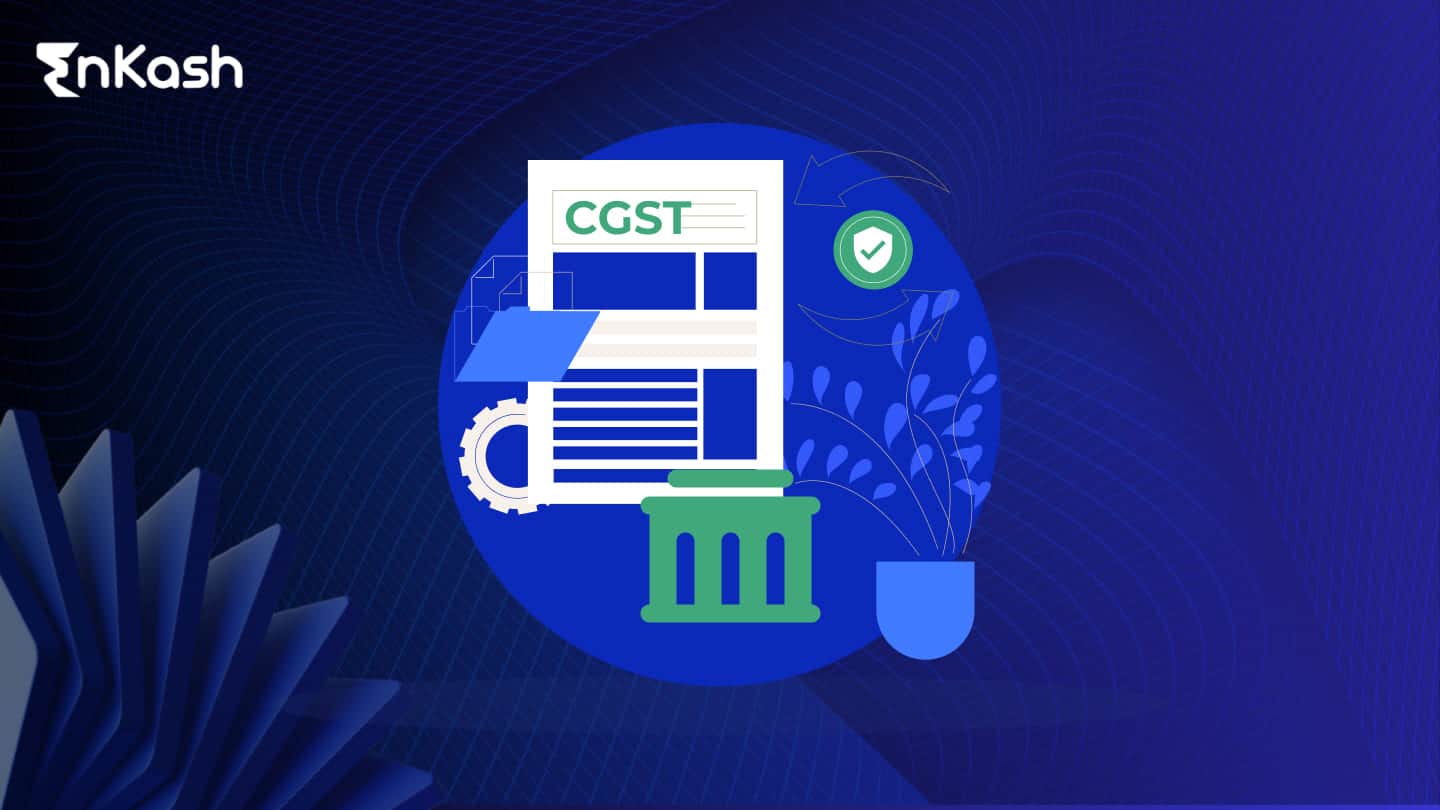Central Goods and Services Tax (CGST) is a tax imposed by the central government. It is applied on the intra-state supplies of goods and services in India. It is part of the GST system that aims for uniform tax compliance throughout the country. CGST applies to transactions within a single state and works alongside State GST (SGST). Both taxes are designed to streamline taxation, by eliminating multiple indirect taxes. It allows businesses to claim input tax credits, leading to a simplified tax system.
Introduction
What is CGST? CGST stands for Central Goods and Services Tax. CGST is applied to the supply of goods and services that take place within a state which are referred to as intra-state transactions. Earlier, intra-state transactions attracted multiple taxes such as Central Excise Duty and Service Tax. CGST was introduced as a part of the Goods and Services Tax (GST) to replace the various indirect taxes.
CGST is levied in conjunction with state GST (SGST) and applied to intra-state transactions. CGST is collected by the Central Government. SGST is collected by the State Government. CGST and SGST eliminate the problem of tax on tax through simplified and a transparent tax structure.
The main benefit of CGST is that it eases tax compliance for business enterprises. It also lets them claim input tax credits (ITC) on the tax they paid on the purchase of goods or services, thereby reducing their tax liability. By clubbing many central taxes into one, CGST has been vital in modernizing India’s taxation structure.
Individuals and businesses need to learn what CGST is and its features to stay compliant with tax regulations.
Read More: Types of GST
What is CGST? – Definition and Scope
The Central Goods and Services Tax (CGST) is a tax imposed by the Central Government on the supply of goods and services within a state. Introduced as part of India’s GST framework, its purpose was to replace several indirect taxes. CGST is governed by the CGST Act, 2017 and applies uniformly across the country.
For every intra-state sale, CGST and SGST are applied, both contributing equally to the total GST. For example, if the GST on a product is 18%, CGST will account for 9%, and SGST will account for the other 9%. The central government collects CGST, while the state government collects SGST, both receiving their share of the revenue.
CGST also offers businesses the benefit of ITC, allowing them to offset the tax they have paid on inputs against their total tax liability. This helps reduce the overall tax burden and streamlines compliance for businesses.
CGST is applicable only to intra-state sales. Integrated GST (IGST) is applied for inter-state transactions. Understanding CGST features is vital for businesses to ensure tax accuracy and smooth functioning of financial operations.
How to Calculate CGST on Goods and Services?
The CGST is levied on all transactions that take place within a state. Once you understand its functioning, calculating CGST becomes easier. For every transaction within a state, the total GST is split 50:50 between CGST (central GST) and SGST (state GST).
Let’s understand with the help of examples. If you buy an item priced at ₹20,000 and it attracts an 18% GST rate, the total tax on the product works out to ₹3,600. The GST amount is further divided into two parts – ₹1,800 as CGST and ₹1,800 as SGST.
The same concept applies to services. For example, if a service costs ₹40,000 and it attracts a 12% GST rate, the total tax would be ₹4,800. Again, this tax is split equally. So ₹2,400 would be CGST, and ₹2,400 would be SGST. Essentially, CGST and SGST, each make up half of the total GST.
CGST is always calculated depending on the total value of the goods or services being sold. This includes additional charges like delivery or handling fees. GST rate varies according to the type of product or service. But it is important to note, that the calculation follows the same structure: divide the total GST between CGST and SGST.
Knowing how to calculate CGST helps businesses not only make accurate tax payments but also charge the right amount of tax. Similarly, consumers know exactly how much of their payment goes towards central and state taxes.
Read More: GST State Code List
What are the CGST Rate Slabs and Categories?
A key feature of CGST is the tax rate slabs under which different goods and services are classified. These slabs provide clarity on the tax rate charged on different products and services. They help ensure tax uniformity across India.
CGST Rate Slabs
CGST is part of the GST system that has multiple rate-slabs between 0% to 28%, based on the type of goods or services. Here’s a breakdown of the key CGST rate slabs:
- 0%: Basic necessities such as foodgrains, fruits, vegetables, and other essentials are exempt from CGST to ensure they are affordable for all.
- 5%: This tax rate slab is applicable to items such as footwear, household equipment, and transportation services, ensuring the public has access to vital goods and services.
- 12%: The product lines under this tax slab are mainly processed food, chemical products and common consumer goods.
- 18%: Under the GST structure, 18% is a common tax slab applicable to several good and services like electronics, furniture and restaurant services.
- 28%: The highest tax slab is reserved for luxury items and demerit goods such as luxury cars, tobacco products and high-end electronics gadgets.
Determination of CGST Rates
CGST rates are specified by the GST Council, which is a body formed by representatives of state and central governments. The council decides on these rates after analyzing the economic conditions and requirements of the different sectors. It also periodically reviews these rates in order to boost the growth of identified industries or to ensure that essential commodities are kept affordable for the general public.
Products and Services Exempted from GST
Most goods and services fall under one of the tax slabs of GST. A few items – like petroleum products, alcohol and electricity – currently remain outside the GST regime. They are taxed individually by central or state governments. These products can be brought under the GST structure over time.
Impact of Tax Slabs on Businesses
By knowing the exact rate applicable under the CGST slab to its goods or services, a business will be able to levy the correct amount of taxes on it, ensuring compliance and adherence to the tax laws. Failure to correctly apply the rate can lead to penalties and financial losses. Further, given the changing tax rates depending on the GST Council’s decisions, it is essential for businesses to stay updated in respect of tax rates and GST notifications.
Impact of Tax Slabs on Consumers
The CGST tax rate slabs directly impact the prices end-users pay for goods and services. For example, the tax rate imposed on essential goods is 0% or 5%. This ensures the products are affordable for all public. On the other hand, luxury products like electronics or cars are non-essential in nature. Thus, they attract a higher tax rate of 28%.
Understanding the CGST tax rate slabs can help businesses and consumers know the impact of taxes on prices and also help them stay compliant with the law.
Comparing CGST with SGST and IGST
The Goods and Services Tax (GST) system in India is based on a dual model, with three branches – CGST (Central Goods and Services Tax), SGST (State Goods and Services Tax), and IGST (Integrated Goods and Services Tax). Each of these taxes function differently based on the nature of the transaction and where it occurs. Knowing the differences between these branches can help businesses stay tax-compliant.
1. CGST vs. SGST
CGST and SGST are levied on intra-state transactions wherein sales of goods or services happen within one state. GST is divided equally between the centre and the state in such situations. If goods are sold in the state of Maharashtra, for example, CGST and SGST are applied, wherein half goes to the centre and the other half to the state.
The tax rates for CGST and SGST are identical for the same transaction, so that both governments receive an identical share of the tax revenue. This establishes the fundamental principle that there should be no double taxation; instead, businesses deal with a single combined tax rate that is split into two parts.
2. CGST vs. IGST
Any transactions between states are charged IGST instead of CGST and SGST. So, a company in Maharashtra selling goods to a company in Gujarat pays IGST instead of CGST and SGST. The central government collects the entire IGST amount and then allocates it between the originating state and destination state in the ratio of their respective shares.
IGST simplifies the process of taxation for inter-state sales. It eliminates the hassle of taxpayers having to deal with both central and state taxes separately. Goods that are imported and exported also come under the umbrella of IGST to ensure a uniform tax structure.
3. Key Differences Between CGST, SGST, and IGST
- Applicable Transactions: CGST and SGST are imposed on intra-state transactions – within a single state. On the other hand, IGST is imposed on inter-state transactions – between different states.
- Collection and Revenue Sharing: CGST is collected by the central government; the state government collects the SGST; IGST is collected by the central government and then distributed to the relevant states as revenue.
- Tax Filing: For intra-state transactions, one must file CGST and SGST returns. For inter-state transactions, one must file IGST returns. The distinction makes it easier for businesses filing returns. It also ensures taxes are allocated to appropriate governments.
Read More: Difference between CGST , SGST and IGST
4. Why is the Dual GST Model Important?
The dual GST model, involving CGST and SGST, was designed to eliminate multiple indirect taxes. It ensures a fair distribution of tax revenues between the central and state governments. The unified tax system makes the movement of goods across states easier. It provides transparency and helps businesses stay compliant while reducing administrative overhead.
In summary, businesses must learn the differences between CGST, SGST, and IGST, as it will help them keep track of taxes and file accurate returns.
How Does CGST Impact Indian Businesses?
The introduction of CGST has significantly impacted businesses across India. CGST is not another standalone tax but a part of a unified GST system designed to streamline India’s tax structure. Knowing how CGST features affect business operations is essential for ensuring legal compliance and optimizing financial management.
1. Simplified Tax Compliance
Prior to the GST, the businesses were required to pay different types of indirect taxes such as Central Excise Duty, Service Tax, and VAT which were imposed separately by central and state governments. In the case of intra-state transactions, CGST has replaced central taxes with a uniformed tax system. This has simplified the tax process and reduced the administrative burden for intra-state transactions, as businesses only need to file CGST and SGST.
2. Input Tax Credit (ITC)
One of the major benefits of CGST for businesses is the input tax credit (ITC) that businesses can claim. For example, if a business can claim credits for taxes paid on inputs – goods and services – used in the production or sale of the end-product or service. ITC is the means to avoid double taxation and lower the overall tax liability.
3. Uniform Tax Rates
The introduction of CGST has ensured consistency in tax rates across states which benefits businesses working across regions. Earlier states had different tax rates for the same goods and services. This would complicate the pricing strategy and make it challenging to keep track of taxes. Today, knowing that CGST rates will be the same across India, businesses can operate and serve their customers better.
4. Impact on Small Businesses
Small businesses have felt both positive and negative effects of CGST. On the plus side, small businesses with a turnover below the stated limit are not required to pay CGST and therefore do not have to deal with the hassle of tax compliance. On the other hand, those with a turnover above the stated limit are required to register for CGST, which will add to the administrative burden.
5. Boost to E-commerce and Inter-state Trade
CGST has positively impacted sectors like e-commerce and inter-state trade. Owing to standardized tax rates, e-commerce platforms can now operate more efficiently. Earlier for the same product, there used to be different state-level indirect taxes. Now they have to pay only one tax (CGST) to all states, making their operations simpler. This has also encouraged the business to focus on expanding their operations across states.
6. Challenges for Businesses
While CGST has helped reduce tax complexity, it also forces businesses to keep track of regulatory changes and make sure they don’t fall behind on filing deadlines. Incorrect or illegal filings invite penalties. Keeping track of ITC necessitates documentation and careful paperwork; this poses a challenge to firms that have complex supply chains.
Overall, CGST features have created a more transparent, simplified, and predictable tax system for businesses. While there are challenges in compliance and management, the uniformity across states has made it a positive change for several Indian businesses.
Read More: Credit Note in GST
How does CGST influence Consumer Prices?
Central Goods and Services Tax (CGST) directly impacts the purchase price, end-users pay for goods and services in India. CGST eliminates multiple layers of tax. The simplified tax structure helps consumers better understand how taxes affect the final price of products.
1. Improved Tax Transparency
Before GST was implemented, all the indirect taxes such as Central Excise Duty, Service Tax and VAT were collected at different points in production and sale. This led to a cascading tax effect, increasing the overall cost of goods and services. CGST has simplified the tax structure. It is because both center and state levy tax at the same rate on intra-state transactions. It also benefits consumers as they know how a product or service is being taxed and what they are paying for.
2. Reduction in Price Variations
CGST has also eliminated price disparities between states to an extent. Prior to GST, states levied their own taxes, resulting in price differences between the same product in different parts of India. Now, as per CGST and SGST tax rules, consumers can expect similar product pricings, irrespective of where they buy the product in the country.
3. Impact on Different Goods and Services
CGST influences the final price depending on the different types of products or services. Necessities like food items are either in low tax slabs or exempted from CGST, making them relatively affordable. On the other hand, luxury goods and services are taxed at higher rates, which increases their final price. Therefore, CGST results in a balanced pricing structure where the bare essentials become more affordable, and non-essentials are relatively more expensive.
In summary, CGST helps to maintain transparency in the pricing of goods and services. It benefits the consumers by reducing the price disparities caused by taxes and avoids the cascading effect of taxes.
Read More: Types of GST Returns
Conclusion
CGST has transformed the functioning of India’s tax system by bringing various central taxes under a common framework. It has helped simplify tax compliance for businesses and make the tax framework more transparent for the common consumer. With GST’s dual mode structure, CGST works alongside SGST, ensuring the central and state governments derive their respective share from intra-state transactions.
The CGST features have positively impacted businesses. For example, businesses can now claim ITC, reducing their overall tax liability. A uniform tax rate in different states has also made it easier for the companies to plan their finances, especially for those having operations in different states.
Aside from providing more transparency and consistency to consumers – who now know what they are paying in tax wherever they live in the country – the simplified tax structure has ended the spiraling effect of multiple indirect taxes. It ensures consumers pay a fair price for goods and services.
CGST plays a major role in India’s modernized tax system. It helps to promote tax compliance, minimize complexity, and encourages equitable distribution of taxes between the center and the states. Understanding what is CGST and its features is essential for businesses and consumers to navigate the country’s tax system.
FAQs
Can a business claim Input Tax Credit (ITC) on CGST paid for services?
Yes, businesses can avail Input Tax Credit (ITC) on CGST paid on services, like they do for goods. The ITC ensures that CGST paid on inputs is not paid again on the output. Thus, tax paid on inputs is set off against taxes levied on the output, reducing the overall tax burden. It helps rescue overall tax liability.
Can incorrect CGST filings attract penalties?
Yes, incorrect CGST filings can lead to penalties. If the CGST returns for a business are inaccurate, or if it is under-reporting, penalties may be imposed by the tax authorities. The standard penalty is 10% of the tax due (subject to a minimum of ₹10,000). In cases of intentional tax evasion, the penalty can be as high as 100% of the tax due.
How does CGST affect e-commerce businesses?
CGST has smoothened the taxation for e-commerce businesses by unifying the tax system across states. Before the introduction of GST, it was a challenge for ecommerce companies to do their business due to complex state taxes and compliance requirements. Under CGST, e-commerce companies collect taxes on all intra-state transactions at the point of sale, making it easier to manage tax compliance. It has also improved the supply chain efficiency for e-commerce businesses by reducing tax-related delays.
How does CGST benefit small businesses?
CGST simplifies the tax structure for small businesses, especially for those operating in a single state. Small businesses with an annual turnover below ₹20 lakh for service providers and ₹40 lakh for goods suppliers are exempted from GST registration. This eases the compliance burden for smaller businesses and helps them avoid complex tax procedures. As the business grows and their turnover increases, they are obligated to comply with CGST rules.
Can CGST rates change over time?
Yes, CGST rates can change over time. CGST rates are set by the GST Council i.e. a body of representatives from the central and state governments. The council revises and modifies CGST rates periodically in view of the socioeconomic conditions, industry demands, or to correct imbalances in the tax structure. Thus, a business needs to keep updated about such changes and accordingly adjust their pricings.
How does CGST impact the final price consumers pay for goods and services?
CGST is one part of the total GST the consumer pays on goods and services. The price that the consumer pays includes both CGST and SGST for intra-state transactions. CGST stops the cascading effect of multiple taxes. While the consumer still pays taxes, the uniform tax structure of GST has made pricing quite transparent.
How does CGST apply to exports and imports?
In the case of exports, CGST is not levied as they are treated as zero-rated supplies under GST. Businesses can claim refunds of taxes paid on inputs for supplies in cases of exports. In the case of imports, IGST is levied and not CGST. Imported goods are subject to IGST payment– which is collected by the center and divided among the center and the states.
What role does CGST play in promoting Make in India?
CGST has helped modernize and streamline the tax system, making it easier for businesses to manufacture goods domestically under the Make in India initiative. By providing a uniform tax rate and providing benefits like ITC, CGST has reduced the overall tax burden on manufacturers. This has encouraged businesses to produce goods within India, boosting local production and contributing to the country’s economic growth.
How does CGST simplify tax administration for businesses?
CGST has simplified tax administration by consolidating multiple central taxes, such as Excise Duty, Service Tax, and Customs Duty, into one tax. This has led to reduced paperwork and complexity. Businesses now only need to manage CGST and SGST for intra-state transactions, making tax compliance easier and more efficient.
How does CGST impact businesses that operate in multiple states?
CGST ensures a uniform tax rate, helping businesses better manage finances and pricing strategies across different states. The dual GST model keeps the tax rate consistent, regardless of the state the business operates in. The consistency has helped businesses reach audiences pan-India and grow while continuing to meet tax requirements and reduce administrative costs.













